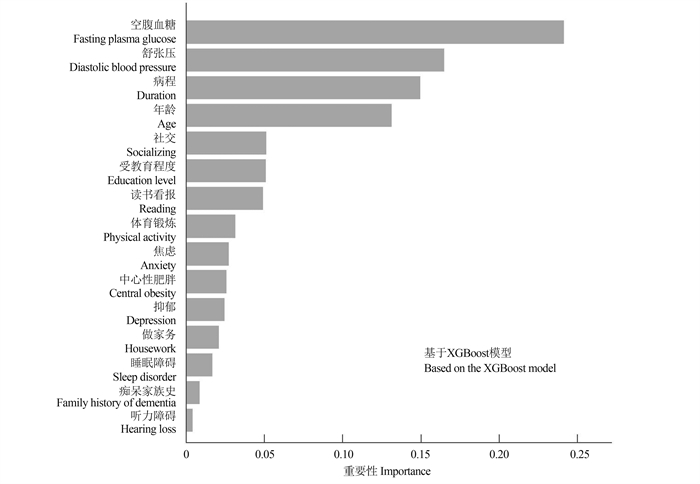Risk assessment of mild cognitive impairment in elderly patients with diabetes mellitus based on machine learning
-
摘要:
目的 基于机器学习构建老年糖尿病患者轻度认知障碍(mild cognitive impairment, MCI)风险评估模型,为老年糖尿病患者认知障碍的早期识别和预防提供参考。 方法 纳入2021年10月―2022年5月就诊于山东省烟台市蓬莱人民医院内分泌科的≥60岁2型糖尿病患者1 319例作为研究对象,调查患者一般人口学特征、身体疾病、生活方式、心理健康状况、生理指标资料,采用蒙特利尔认知评估量表(Montreal cognitive assessment, MoCA)评估患者认知功能。利用R 4.1.3软件构建反向传播(back propagation, BP)神经网络模型、随机森林模型、XGBoost模型,并计算模型准确率、灵敏度、特异度、阳性预测值、阴性预测值、F1评分、AUC值及其95% CI。 结果 BP神经网络模型、随机森林模型、XGBoost模型的灵敏度分别为57.79%、77.89%、80.40%,特异度分别为78.17%、60.41%、61.42%,AUC分别为0.746(95% CI: 0.698~0.794)、0.755(95% CI: 0.708~0.802)、0.756(95% CI: 0.709~0.803)。 结论 XGBoost模型和随机森林模型具有较好的性能,在老年糖尿病患者MCI风险评估领域具有一定的应用前景。 Abstract:Objective This study aims to develop a high-accuracy risk assessment model for identifying the risk of mild cognitive impairment (MCI) in elderly patients with diabetes mellitus using machine learning algorithms, providing insights for early identification and prevention of cognitive impairment in this population. Methods A total of 1 319 patients aged 60 and above with type 2 diabetes mellitus, who visited the Endocrinology Department of People′s Hospital of Penglai in Yantai City, Shandong Province, between October 2021 and May 2022, were enrolled as the study population. The demographic information, medical history, lifestyle factors, psychological health status, and physiological indicators were collected. The Montreal Cognitive Assessment (MoCA) scale was used to evaluate the cognitive function of patients. BP neural network model, random forest model, and XGBoost model were constructed using R version 4.1.3 software. The accuracy, sensitivity, specificity, positive predictive value, negative predictive value, F1 score, and the area under the curve (AUC) with 95% CI of models were calculated. Results The sensitivity values of the BP neural network model, random forest model, and XGBoost model were 57.79%, 77.89%, and 80.40%, respectively. The specificity values were 78.17%, 60.41%, and 61.42% for the respective models. The AUC values for the ROC curves were 0.746 (95% CI: 0.698-0.794), 0.755 (95% CI: 0.708-0.802), and 0.756 (95% CI: 0.709-0.803), respectively. Conclusions The XGBoost model and random forest model demonstrated good performance and showed potential for application in the field of MCI risk assessment among elderly patients with diabetes mellitus. -
表 1 老年糖尿病患者基本情况
Table 1. Characteristics of elderly patients with diabetes mellitus
特征Characteristic MoCA筛查 ① MoCA test ① t/χ2/Z值value P值
value正常Normal MCI 总人群Total population 662(50.2) 657(49.8) 年龄/岁Age/years 67.6±5.0 68.4±5.2 -2.68 0.008 年龄组/岁Age group/years 7.17 0.067 60~<65 218(32.9) 176(26.8) 65~<70 211(31.9) 232(35.3) 70~<75 175(26.4) 176(26.8) ≥75 58(8.8) 73(11.1) 性别Gender 0.85 0.354 男Male 355(53.6) 369(56.2) 女Female 307(46.4) 288(43.8) 婚姻状况Marital status 0.18 0.672 未婚Unmarried 29(4.4) 32(4.9) 已婚Married 633(95.6) 625(95.1) 受教育程度Education level 7.97 0.047 小学及以下Primary school or below 123(18.6) 129(19.6) 初中Junior middle school 308(46.5) 321(48.9) 高中/中专High school/technical secondary school 181(27.3) 181(27.5) 大专/大学及以上Junior college/university or above 50(7.6) 26(4.0) 痴呆家族史Family history of dementia 11(1.7) 37(5.6) 14.82 <0.001 病程/年Duration/years 7(4, 13) 9(5, 14) 4.72 <0.001 病程分组/年Duration group/years 32.76 <0.001 0~<5 231(34.9) 138(21.0) 5~<10 174(26.3) 228(34.7) ≥10 257(38.8) 291(44.3) 身体疾病Physical disease 高血压Hypertension 119(18.0) 142(21.6) 2.75 0.097 高血脂Hyperlipidemia 65(9.8) 87(13.2) 3.79 0.052 心脑血管病Cardiovascular and cerebrovascular diseases 40(6.0) 57(8.7) 3.36 0.067 听力障碍Hearing loss 13(2.0) 38(5.8) 12.94 <0.001 生活方式Lifestyle 独居Living alone 8(1.2) 10(1.5) 0.24 0.624 吸烟Smoking 104(15.7) 128(19.5) 3.24 0.072 饮酒Drinking 86(13.0) 101(15.4) 1.54 0.215 体育锻炼Physical activity 460(69.5) 360(54.8) 30.26 <0.001 做家务Housework 550(83.1) 501(76.3) 9.49 0.002 读书看报Reading 334(50.5) 234(35.6) 29.60 <0.001 生活方式Lifestyle 参与社交Socializing 307(46.4) 199(30.3) 36.05 <0.001 睡眠障碍Sleep disorder 67(10.1) 133(20.2) 26.27 <0.001 心理健康Mental health 抑郁Depression 35(5.3) 114(17.4) 47.86 <0.001 焦虑Anxiety 20(3.0) 90(13.7) 49.14 <0.001 BMI /(kg·m-2) 25.5±3.2 25.6±3.0 -0.89 0.376 BMI分组group 1.77 0.413 偏瘦/正常Lean/normal 216(32.6) 193(29.4) 超重Overweight 318(48.0) 336(51.1) 肥胖Obesity 128(19.4) 128(19.5) 中心性肥胖Central obesity 333(50.3) 292(44.4) 4.53 0.033 收缩压/mmHg Systolic blood pressure /mmHg 134.1±13.6 135.2±14.1 -1.43 0.153 舒张压/mmHg Diastolic blood pressure /mmHg 77.4±8.7 79.2±9.5 -3.63 <0.001 空腹血糖/(mmol·L-1) Fasting plasma glucose /(mmol·L-1) 7.8±1.8 8.2±2.1 -2.94 0.003 注:MoCA,蒙特利尔认知评估量表;MCI, 轻度认知功能障碍。
①以人数(占比/%)、x±s或M(P25,P75)表示。
Note: MoCA,Montreal cognitive assessment; MCI, mild cognitive impairment.
① Number of people(proportion/%) or x±s or M(P25,P75).表 2 模型在测试集的样本分类结果
Table 2. Model classification results on the test set
模型
Model评估
ClassificationMoCA筛查 ① MoCA test ① 合计
Total正常Normal MCI BPNN 正常Normal 154(78.17) 84(42.21) 238 MCI 43(21.83) 115(57.79) 158 RF 正常Normal 119(60.41) 44(22.11) 163 MCI 78(39.59) 155(77.89) 233 XGboost 正常Normal 121(61.42) 39(19.60) 160 MCI 76(38.58) 160(80.40) 236 合计Total 197(100.00) 199(100.00) 396 注:BPNN,反向传播神经网络;RF,随机森林;XGBoost,极端梯度提升树;MoCA,蒙特利尔认知评估量表;MCI,轻度认知障碍。
①以人数(占比/%)表示。
Note: BPNN,back propagation neural network; RF,random forest; XGBoost,extreme gradient boosting;MoCA,Montreal cognitive assessment;MCI,mild cognitive impairment.
① Number of people(proportion/%).表 3 模型在测试集的评估性能比较
Table 3. Performance comparison of the model on the test set
评价指标Indicator BPNN
模型
modelRF
模型
modelXGboost
模型
model准确率/% Precision/% 67.93 69.19 70.96 灵敏度/% Sensitivity/% 57.79 77.89 80.40 特异度/% Specificity/% 78.17 60.41 61.42 阳性预测值/% Positive predictive value/% 72.78 66.52 67.80 阴性预测值/% Negative predictive value/% 64.70 73.01 75.63 F1分数/% F1 score/% 0.644 0.717 0.736 注:BPNN,反向传播神经网络;RF,随机森林;XGBoost,极端梯度提升树。
Note: BPNN,back propagation neural network;RF,random forest; XGBoost,extreme gradient boosting.表 4 模型AUC的比较
Table 4. AUC comparison of the three model
模型Model AUC差值
difference95% CI Z值
valueP值
valueBPNN∶RF 0.009 -0.027~0.045 0.503 0.615 BPNN∶XGBoost 0.010 -0.031~0.052 0.483 0.629 RF∶XGBoost 0.001 -0.020~0.022 0.092 0.927 注:AUC,曲线下面积;BPNN,反向传播神经网络;RF,随机森林;XGBoost,极端梯度提升树。
Note: AUC, area under the curve; BPNN,back propagation neural network;RF,random forest; XGBoost,extreme gradient boosting. -
[1] Li YZ, Teng D, Shi XG, et al. Prevalence of diabetes recorded in mainland China using 2018 diagnostic criteria from the American Diabetes Association: national crosssectional study[J]. BMJ, 2020, 369: m997. DOI: 10.1136/bmj.m997. [2] Anderson ND. State of the science on mild cognitive impairment (MCI)[J]. CNS Spectr, 2019, 24(1): 78-87. DOI: 10.1017/S1092852918001347. [3] Groeneveld O, Reijmer Y, Heinen R, et al. Brain imaging correlates of mild cognitive impairment and early dementia in patients with type 2 diabetes mellitus[J]. Nutr Metab Cardiovasc Dis, 2018, 28(12): 1253-1260. DOI: 10.1016/j.numecd.2018.07.008. [4] 国家老年医学中心, 中华医学会老年医学分会, 中国老年保健协会糖尿病专业委员会. 中国老年糖尿病诊疗指南(2021年版)[J]. 中华糖尿病杂志, 2021, 13(1): 14-46. DOI: 10.3760/cma.j.cn115791-20201209-00707.National Center of Gerontology, Chinese Society of Geriatrics, Diabetes Professional Committee of Chinese Aging Well Association. Guidelines for the management of diabetes mellitus in the elderly in China (2021 edition)[J]. Chin J Diabetes Mellit, 2021, 13(1): 14-46. DOI: 10.3760/cma.j.cn115791-20201209-00707. [5] 中华医学会内分泌学分会. 糖尿病患者认知功能障碍专家共识[J]. 中华糖尿病杂志, 2021, 13(7): 678-694. DOI: 10.3760/cma.j.cn115791-20210527-00291.Chinese Society of Endocrinology. Expert consensus on diabetic cognitive dysfunction[J]. Chin J Diabetes Mellit, 2021, 13(7): 678-694. DOI: 10.3760/cma.j.cn115791-20210527-00291. [6] 中华医学会, 中华医学会杂志社, 中华医学会全科医学分会, 等. 肥胖症基层诊疗指南(2019年)[J]. 中华全科医师杂志, 2020, 19(2): 95-101. DOI: 10.3760/cma.j.issn.1671-7368.2020.02.002.Chinese Medical Association, Chinese Medical Journals Publishing House, Chinese Society of General Practice, et al. Guideline for primary care of obesity(2019)[J]. Chin J Gen Pract, 2020, 19(2): 95-101. DOI: 10.3760/cma.j.issn.1671-7368.2020.02.002. [7] 温洪波, 张振馨, 牛富生, 等. 北京地区蒙特利尔认知量表的应用研究[J]. 中华内科杂志, 2008, 47(1): 36-39. https://www.cnki.net/KCMS/detail/detail.aspx?dbcode=IPFD&filename=ZKXL201201001058&dbname=IPFD9914Wen HB, Zhang ZX, Niu FS, et al. The application of Montreal cognitive assessment in urban Chinese residents of Beijing[J]. Chin J Intern Med, 2008, 47(1): 36-39. https://www.cnki.net/KCMS/detail/detail.aspx?dbcode=IPFD&filename=ZKXL201201001058&dbname=IPFD9914 [8] 王杰. 轻度认知障碍危险因素的识别及BP神经网络预测模型的构建[D]. 湖州: 湖州师范学院, 2020.Wang J. Study on identification risk factors of mild cognitive impairment and construction of BP network prediction model[D]. Huzhou: Huzhou University, 2020. [9] Climent MT, Pardo J, Muñoz-Almaraz FJ, et al. Decision tree for early detection of cognitive impairment by community pharmacists[J]. Front Pharmacol, 2018, 9: 1232. DOI: 10.3389/fphar.2018.01232. [10] Chen TQ, Guestrin C. XGBoost: a scalable tree boosting system[C]. San Francisco: Proceedings of the 22nd ACM SIGKDD International Conference on Knowledge Discovery and Data Mining, 2016: 785-794. [11] 齐巧娜, 刘艳, 陈霁晖, 等. 机器学习XGBoost算法在医学领域的应用研究进展[J]. 分子影像学杂志, 2021, 44(5): 856-862. DOI: 10.12122/j.issn.1674-4500.2021.05.25.Qi QN, Liu Y, Chen JH, et al. Research progress on machine learning XGBoost algorithm in medicine[J]. J Mol Imag, 2021, 44(5): 856-862. DOI: 10.12122/j.issn.1674-4500.2021.05.25. [12] Arnold SE, Arvanitakis Z, Macauley-Rambach SL, et al. Brain insulin resistance in type 2 diabetes and Alzheimer disease: concepts and conundrums[J]. Nat Rev Neurol, 2018, 14(3): 168-181. DOI: 10.1038/nrneurol.2017.185. [13] Umegaki H, Iimuro S, Shinozaki T, et al. Risk factors associated with cognitive decline in the elderly with type 2 diabetes: pooled logistic analysis of a 6-year observation in the Japanese Elderly Diabetes Intervention Trial[J]. Geriatr Gerontol Int, 2012, 12(Suppl 1): 110-116. DOI: 10.1111/j.1447-0594.2011.00818.x. [14] Gao YX, Xiao YY, Miao RJ, et al. The prevalence of mild cognitive impairment with type 2 diabetes mellitus among elderly people in China: a cross-sectional study[J]. Arch Gerontol Geriatr, 2016, 62: 138-142. DOI: 10.1016/j.archger.2015.09.003. -





 下载:
下载:


